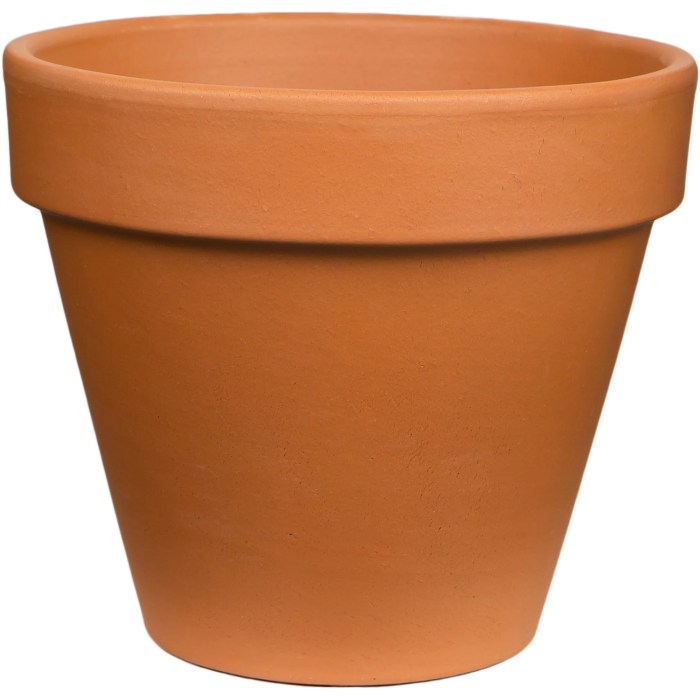Product Overview

18 inch plant pot – Ah, the majestic 18-inch plant pot! A vessel of horticultural dreams, a statement piece for your green thumbed kingdom. These aren’t your grandma’s chipped terracotta saucers; we’re talking serious plant-holding real estate here. Let’s delve into the fascinating world of oversized planters.
An 18-inch plant pot, as the name suggests, boasts a diameter of approximately 18 inches. This substantial size allows for the cultivation of larger plants, providing ample root space for healthy growth. They often feature drainage holes at the base to prevent waterlogging, a common nemesis of even the most experienced gardeners. Some designs incorporate decorative elements, adding an aesthetic touch to your garden or interior space.
The height will vary depending on the pot’s style and material, but generally, expect a sizable container.
Materials Used in 18-Inch Plant Pot Manufacturing
The choice of material significantly impacts both the pot’s aesthetic appeal and its practical functionality. Several materials are commonly employed, each with its unique advantages and disadvantages.
The sheer size of an 18-inch plant pot dictates a certain aesthetic; it demands presence. The choice of color, therefore, becomes a political statement. For those seeking a bolder, more imposing presence, consider the options available in black outdoor plant pots , which often offer a stark contrast against natural settings. Ultimately, the impact of even an 18-inch pot hinges on such carefully considered design choices.
Material Comparison: Advantages and Disadvantages, 18 inch plant pot
Choosing the right material is crucial. Consider your budget, the plant’s needs, and your personal style when making your selection. Each material brings a unique set of pros and cons to the table.
| Material | Average Price (USD) | Pros | Cons |
| Ceramic | $30 – $150+ | Elegant appearance, good drainage, durable (if high quality) | Heavy, prone to cracking/chipping, can be expensive |
| Plastic | $15 – $50 | Lightweight, inexpensive, durable, comes in various colors and styles | Can fade in sunlight, may not look as aesthetically pleasing as other materials, less durable than high-quality ceramic or concrete. |
| Concrete | $40 – $100+ | Very durable, modern aesthetic, heavy and stable | Can be heavy and difficult to move, porous, may require sealing to prevent water damage |
| Fiberglass | $50 – $200+ | Lightweight, strong, resistant to cracking, can mimic the look of other materials | Can be expensive, may require special care or coatings |
Styling and Placement

An 18-inch plant pot is no mere vessel; it’s a statement piece, a horticultural heavyweight champion, demanding respect (and maybe a slightly stronger back for moving it). Its substantial size allows for impressive displays, but careful consideration of styling and placement is key to unleashing its full potential, transforming a simple pot into a design triumph. Let’s delve into the art of the 18-inch pot placement.
Integrating an 18-inch plant pot successfully hinges on understanding its scale and the overall aesthetic of your space. A gargantuan pot in a minimalist room can feel overwhelming, while a petite plant in a massive pot can look, well, lost. The trick is to find the perfect balance, creating a visually harmonious relationship between the pot, the plant, and the surrounding décor.
Aesthetic Integration with Home Decor Styles
The versatility of an 18-inch plant pot is truly remarkable. In a modern minimalist setting, a sleek, ceramic pot in a neutral tone can anchor a room, offering a touch of organic texture. Conversely, a rustic terracotta pot, perhaps slightly distressed for added character, could add warmth and charm to a farmhouse-style interior. For a bohemian vibe, consider a brightly colored, patterned pot, possibly even a hand-painted one, to inject personality and vibrancy.
The possibilities are as limitless as your imagination (and your local garden center’s stock).
Placement Options Considering Sunlight and Space
The placement of your 18-inch pot is crucial for the health of your plant. Sunlight requirements vary greatly depending on the species, so thorough research is essential. A south-facing window might be ideal for sun-loving plants, but could scorch more delicate varieties. Conversely, a north-facing window, while offering less direct sunlight, might be perfect for shade-tolerant plants.
Remember, even with a large pot, space is a factor. Ensure that the pot isn’t obstructing walkways or creating a hazardous tripping hazard (unless, of course, you’re aiming for a delightfully chaotic, “lived-in” look—then, go for it!). Consider the overall flow of your room and how the pot will interact with the existing furniture and décor.
Creative Uses Beyond Traditional Planting
Think outside the (plant) pot! While planting is the most obvious use, an 18-inch pot can serve as a striking decorative element even without greenery. Imagine it as a unique side table, topped with a glass surface and a stylish lamp. Or perhaps as a dramatic centerpiece for a living room, filled with colorful pebbles and candles for a cozy ambiance.
For the truly adventurous, it could even become a quirky planter stand for smaller pots, creating a miniature botanical garden within a garden. The possibilities are, quite frankly, astonishing.
Common Queries: 18 Inch Plant Pot
How often should I water an 18-inch plant pot?
Watering frequency depends on the plant, pot material, and weather. Check the soil moisture – water when the top inch feels dry.
What kind of soil is best for 18-inch pots?
Well-draining potting mix is key. Amend with perlite or vermiculite to improve drainage if needed.
Can I over-fertilize plants in large pots?
Yes! Always follow fertilizer instructions carefully. Over-fertilizing can burn roots.
How do I prevent root rot in an 18-inch pot?
Ensure excellent drainage with holes in the bottom and use a well-draining potting mix. Avoid overwatering.